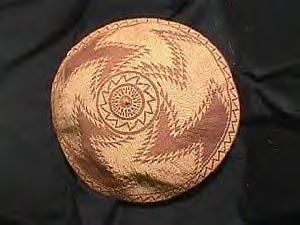|
|
Canku Ota |
|
|
(Many Paths) |
||
|
An Online Newsletter Celebrating Native America |
||
|
april 21, 2001 - Issue 34 |
||
|
|
||
|
Class Preserves Luiseno Culture |
||
|
By Ray Patterson SignOn San Diego |
 Julie Schneider
Ljubenkov has been learning the culture of the Luiseno Indians while teaching art and nature classes at the Rincon
Reservation. Julie Schneider
Ljubenkov has been learning the culture of the Luiseno Indians while teaching art and nature classes at the Rincon
Reservation.She has learned Luiseno stories told by Roberta Osuna, her teaching partner, and she's even learned some of the language. The two teach classes to third-to eighth-graders at the Rincon Indian Education Center. One of their 10-week courses recently finished, and they plan to start another this summer. Some of the sessions are open to the public. Osuna, 41, teaches stories passed down through generations, and she teaches the Luiseno language. She said the long-term goal of the classes is to produce a book of stories to be illustrated by children. "I worked for Rincon Head Start developing cultural curriculum," Osuna said. "It was pointed out to me that you could not find any children's Luiseno stories in any library. It never occurred to me because you can go into the public library and pull all kinds of children's books in a lot of other Native American cultures. We knew we had the stories here handed down through oral tradition, but they weren't being used, and we needed to start using them." The students draw in each of the classes. They also hear about a variety of subjects presented by guest speakers. Ljubenkov, 43, has been teaching art since 1985 and is also teaching extension classes at the University of California San Diego and MiraCosta College. "These stories are chock-full of historical information and ecological information about plants and animals because that was their life living here," Ljubenkov said. She said the classes are designed to do more than help students chronicle their cultural past. "The main thing is wanting people to appreciate where they live," she said. "Appreciate the plants, animals and the landscape before it is too late and we lose all of it." Bill Haas, a biologist and an expert on the arroyo toad, was a recent guest speaker. He brought several amphibians in terrariums for the students to draw. Other visitors to the class have included a red-tailed hawk and a barn owl, brought by Sky Hunters, a raptor education group that cares for birds that cannot be released back into the wild. Although the class usually has six to 15 students, some of the presentations have been open to the public. About 35 people came to a lecture and slide show about rock art by rock art researcher Steven Freers. After his presentation, the audience had the opportunity to paint rocks with Luiseno and other American Indian designs. Ljubenkov helps the children develop their skills drawing plants, animals and Luiseno designs, while Osuna provides the language instruction. Osuna's 84-year-old father, Sam Reed, is one of several Luiseno speakers who is telling and recording the stories to be passed on. "Part of our work was to video record him and some other elders speaking," Osuna said. "We have learned from them, and in that way, we pass it on to the children." |
|
|
Pechanga Band of Luiseno Indians |
|
|
Temecula History |
|
|
The La Jolla Band of Luiseno
Indians |
|
|
||
|
|
||
| Canku Ota is a free Newsletter celebrating Native America, its traditions and accomplishments . We do not provide subscriber or visitor names to anyone. Some articles presented in Canku Ota may contain copyright material. We have received appropriate permissions for republishing any articles. Material appearing here is distributed without profit or monetary gain to those who have expressed an interest. This is in accordance with Title 17 U.S.C. section 107. | ||
|
Canku Ota is a copyright © 2000, 2001 of Vicki Lockard and Paul Barry. |
||
|
|
|
|
|
The "Canku Ota - A Newsletter Celebrating Native America" web site and its design is the |
||
|
Copyright © 1999, 2000, 2001 of Paul C. Barry. |
||
|
All Rights Reserved. |
